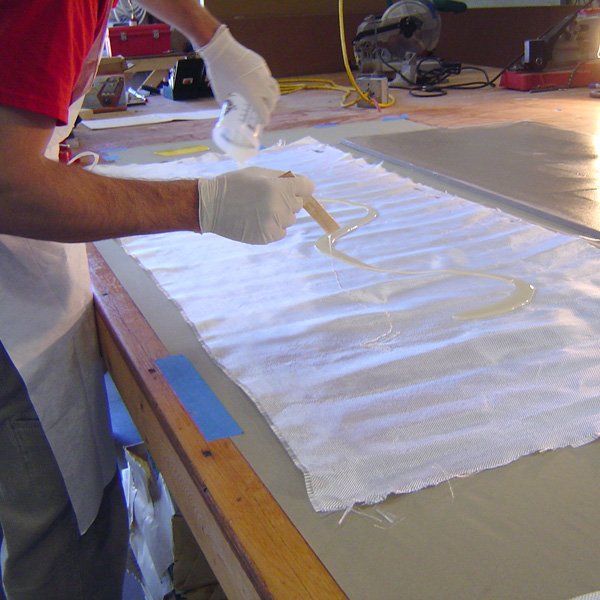That looks fine for cloth. Unless your building an airplane, your most important criteria is ease of working. You can make the whole process more complex, and in fact, if you are really going for performance, it is. That said, you can make VERY light and strong parts with very minimal wherewithal with a little planning and a couple of tricks. 99% of the time, I use very light glass CLOTH and epoxy resin. I recommend using the same despite the rather large price in cost of the epoxy. I think it is a lot easier to use, and is much stronger. I very rarely use molds (only if I make something really complex and have strong belief of using it again. Really good molds are super expensive if you make something complex) and never use gelcoat. Go to a marine store and get the lightest cloth they have - they should have "finishing cloth" and buy this epoxy here:
http://www.epoxyproducts.com/noblush.html . The fine cloth is easy to use and makes extremely strong parts with a few laminates. You can make damn near anything with these two materials.
The first "trick" is to make very careful and accurate foam models of what you want. The best thing to use is styrofoam (picnic coolers and cups are not actually styrofoam but expanded polystyrene which will NOT work!) but it is pretty pricey. Urethane foam is very good also but sometimes hard to find (try an industrial insulation vendor) but green florists foam is fine if a twinge expensive. Take whatever time it takes to make a perfect exact size model of what you want, and then sand it a bit smaller - whatever thickness of glass you want in all dimensions. Then you simply laminate glass layers over the form and you have your part. I often use polyester body filler (regular ol' Bondo) to glue foam together and mount blocks temporarily to a frame etc. I build lots of parts right in place - right on a bike frame for instance but you have to comprehensively mask off EVERYTHING within several feet of where you are working unless you are psychotically neat.
Likely you will come up with a shape that has compound curves and the cloth will strongly resist smoothly conforming to the shape and you will wish you had bought chop strand mat instead. Stick with the cloth unless you want crazy heavy and weak parts! There is a solution. The second "trick" is to carefully cut out your pieces of cloth so they will lay flat on your compound surface. This means you will have to cut wedge shaped reliefs in various places to avoid overlaps and/or use multiple pieces to fit over your shape. Cut all the components you will need for the session first and take your time to do a precision job. You can leave extra at the edges, but time spent here will pay heavily when you lay them up. To make them stay in place, mix just enough epoxy to paint the surface of your foam form. don't allow ANY epoxy to get on your cloth laminates. Once the epoxy has started to "kick" (don't wait too long) it will be very sticky and you can lay on a layer of cloth and smooth it out flawlessly with a credit card squeegee. It might take a little fussing, but as the epoxy cures it will eventually very tightly bite on the cloth and not let go. The epoxy needs to be sticky enough that it doesn't soak into the cloth. You can get PERFECT smooth layers that flawlessly conform to the craziest shapes this way. Once you are sure the layer of cloth will stay tightly stuck in place you can mix up some more epoxy and saturate the cloth. Don't worry about the wet epoxy - it will not soften up the first painted on layer and let your cloth go. Epoxy is not a solvent and fresh batches will not dissolve an earlier batch that has started reacting. Squeegee as much epoxy back out of the cloth as you can, and wait for it to get sticky just like the first painted on coat. Then you can stick on your next laminate of cloth. Then saturate and squeegee the excess. Repeat until you have the thickness you want. You can use this same technique with polyester resin if you want to save some money, but you should at least try the epoxy and decide for yourself.
The foam is super soft and you can easily carve, scrape and sand it out of your new part after the epoxy cures. Many epoxys take rather a long time (like polyester resin does) to keep a really permanent shape despite seeming totally hard and cured. So if you make something like a seat pan, you should think of leaving the foam intact and your part on your frame etc for a week or so so it keeps its exact shape. If your part needs to be hollow, you can cut an access hole or cut it in half, scrape out the foam and then epoxy the joint back together with a recess and a couple of strips of cloth laminated over the joint.
After you are done and satisfied with the part you can fill the weave of the cloth with a filler mixed with epoxy (as previously suggested) and sand it flat to a paintable finish.
This seat/tail section was made in this exact way, is very strong and weighs less than 2 pounds. You can see the green florists foam is still inside the tail piece.



